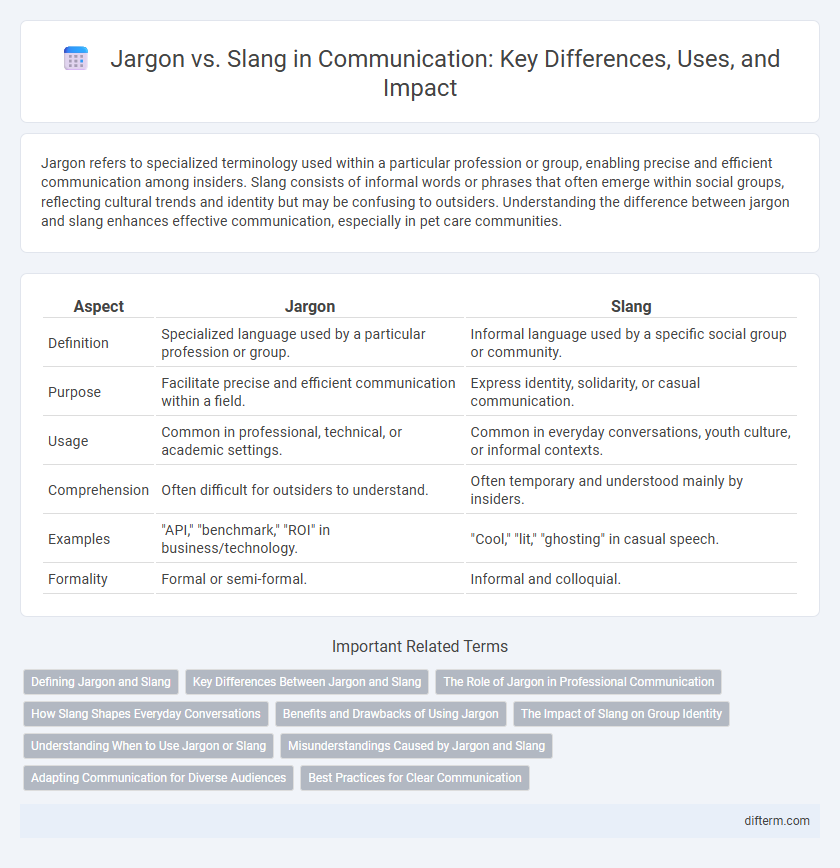Jargon refers to specialized terminology used within a particular profession or group, enabling precise and efficient communication among insiders. Slang consists of informal words or phrases that often emerge within social groups, reflecting cultural trends and identity but may be confusing to outsiders. Understanding the difference between jargon and slang enhances effective communication, especially in pet care communities.
Table of Comparison
| Aspect | Jargon | Slang |
|---|---|---|
| Definition | Specialized language used by a particular profession or group. | Informal language used by a specific social group or community. |
| Purpose | Facilitate precise and efficient communication within a field. | Express identity, solidarity, or casual communication. |
| Usage | Common in professional, technical, or academic settings. | Common in everyday conversations, youth culture, or informal contexts. |
| Comprehension | Often difficult for outsiders to understand. | Often temporary and understood mainly by insiders. |
| Examples | "API," "benchmark," "ROI" in business/technology. | "Cool," "lit," "ghosting" in casual speech. |
| Formality | Formal or semi-formal. | Informal and colloquial. |
Defining Jargon and Slang
Jargon consists of specialized terms and phrases used within a specific profession or group to convey precise meanings efficiently. Slang refers to informal, often transient language expressions that reflect cultural trends and social identity but lack standardized definitions. Both serve distinct roles in communication, with jargon enhancing clarity among experts and slang fostering social connection among peers.
Key Differences Between Jargon and Slang
Jargon consists of specialized terms used within professional or technical fields to convey precise meanings, enhancing clarity among experts. Slang comprises informal, often playful expressions used within social groups to foster identity and express cultural trends. While jargon prioritizes function and accuracy, slang emphasizes creativity and social connection.
The Role of Jargon in Professional Communication
Jargon serves as a precise and efficient language within professional communication, enabling experts to convey complex concepts quickly and accurately. It fosters clarity and shared understanding among specialists while reducing ambiguity in technical discussions. However, jargon can create barriers for non-experts, making it essential to balance its use with clear explanations to maintain effective communication.
How Slang Shapes Everyday Conversations
Slang transforms everyday conversations by introducing informal, culturally rich expressions that create a sense of identity and belonging among speakers. Unlike jargon, which is specialized language used within specific professional or technical groups, slang evolves rapidly and reflects current social trends and attitudes. This dynamic linguistic element enhances communication by making interactions more relatable, expressive, and contextually nuanced.
Benefits and Drawbacks of Using Jargon
Jargon enhances communication efficiency within specific professional or social groups by providing precise and concise terms that convey complex ideas quickly. However, its use can create barriers for outsiders, reducing clarity and inclusivity in broader communication settings. Overreliance on jargon may lead to misunderstandings and exclude individuals unfamiliar with the specialized vocabulary.
The Impact of Slang on Group Identity
Slang profoundly shapes group identity by fostering a sense of belonging and exclusivity among members, distinguishing insiders from outsiders through unique linguistic markers. Unlike jargon, which is specialized language tied to professional or technical fields, slang evolves rapidly and reflects cultural trends, social attitudes, and shared experiences within groups. The dynamic nature of slang enhances group cohesion while simultaneously signaling social boundaries, reinforcing collective identity and solidarity.
Understanding When to Use Jargon or Slang
Jargon consists of specialized terms used within a particular profession or group, enhancing precision and clarity among experts. Slang, on the other hand, is informal language that often reflects cultural trends and social identity, fostering casual connection. Effective communication requires recognizing your audience and purpose to choose jargon for technical accuracy or slang for relatability and engagement.
Misunderstandings Caused by Jargon and Slang
Misunderstandings caused by jargon and slang often arise because jargon consists of specialized terms specific to a profession or group, which can be unintelligible to outsiders. Slang varies regionally and culturally, leading to confusion or misinterpretation among different social groups. Both can create communication barriers by obscuring the intended message and limiting effective interaction between diverse audiences.
Adapting Communication for Diverse Audiences
Effective communication requires adapting language to suit diverse audiences, distinguishing between jargon and slang is crucial in this process. Jargon consists of specialized terms used within professional or technical fields, facilitating precise and efficient communication among experts but potentially alienating laypersons. Slang, characterized by informal and often transient expressions, connects speakers within social groups but can hinder understanding across different demographics or cultural backgrounds.
Best Practices for Clear Communication
Using jargon in communication can enhance clarity when addressing specialized audiences familiar with technical terms, ensuring precision and efficiency. Slang, while enriching informal conversation and building rapport, risks misunderstandings due to its variability and cultural specificity. Best practices for clear communication include tailoring language to the audience, minimizing excessive jargon or slang, and prioritizing simple, direct expressions to maximize comprehension.
jargon vs slang Infographic

 difterm.com
difterm.com